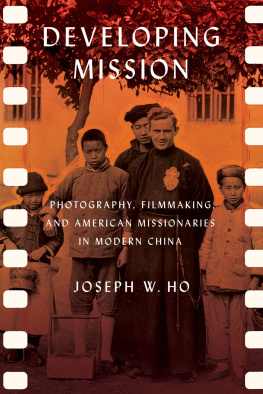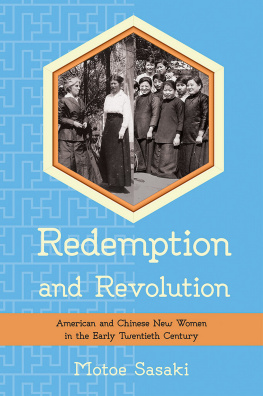Copyright 1995 by The University Press of Kentucky
Scholarly publisher for the Commonwealth,
serving Bellarmine College, Berea College, Centre
College of Kentucky, Eastern Kentucky University,
The Filson Club, Georgetown College, Kentucky
Historical Society, Kentucky State University,
Morehead State University, Murray State University,
Northern Kentucky University, Transylvania University,
University of Kentucky, University of Louisville,
and Western Kentucky University.
Editorial and Sales Offices: Lexington, Kentucky 40508-4008
Library of Congress Cataloging-in-Publication Data
Lodwick, Kathleen L.
Educating the women of Hainan : the career of Margaret Moninger in China, 1915-1942 / Kathleen L. Lodwick.
p. cm.
Includes bibliographical references and index.
ISBN: 978-0-8131-5630-9
1. Moninger, Mary Margaret, 1891-1950. 2. Women missionariesChinaBiography. 3. Women missionariesUnited StatesBiography. 4. Presbyterian Church in the U.S.A. Hainan MissionHistory. 5. Presbyterian ChurchEducationHistory. 6. WomenEducationChinaHistory20th century. I. Title.
BV3427.M516L63 1995
266.51092dc20
[B] 94-29319
Foreword
AS A HISTORIAN, Kathleen L. Lodwick, it seems, was inevitably drawn into the huge trove of Mary Margaret Moningers letters once she discovered their order and clarity in the Presbyterian Mission archives. Miss Moningers letters record in measured weekly installments her twenty-three years as a missionary on Hainan Island. These letters were written in an open, balanced schoolmarms hand with a favorite Waterman pen on Sunday afternoons and posted by long stages, overland and overseas, in order to present to her family a seemingly casual, but carefully crafted, portrait of her life as a teacher, a missionary, and a member of a remote and small American mission community. These letters are newsy and intimate in a familial, conversational manner and consequently speak almost as clearly across the years separating us from Margaret Moninger as they did to her family in Iowa. Kathleen carefully edited the letters, supplemented them with forays into other archives, as well as with interviews, and wove these materials into a narrative that follows closely the chronology of Margaret Moningers service and limits itself to the subjects that Miss Moninger herself raised. Kathleen felt little need to impose an interpretive scheme and skillfully and unobtrusively lets Margaret Moninger speak for herself.
Much of Margaret Moningers life remains in shadows, but Margaret herself intentionally created those spaces where we cannot see, and rather than speculate about them, Kathleen shows us Margarets self-portrait in a careful chronological narrative structure built around the stages of Margaret Moningers missionary service: begun deliberately with understated commitment, established and maintained with determination, punctuated by sabbatical leaves or by political upheavals, and ended not really by World War II but by her own illness. The result is a view through an intended window into Margaret Moningers life.
The values reflected in these letters and this life are familiar to students of the American missionary movement of the nineteenth and twentieth centuries. Margaret Moninger was part of a community of people dedicated to, indeed often truly absorbed by, their calling. Wherever they went in the twentieth century, they built American-style churches, houses, schools, and hospitals. They taught and preached about Christianity and lived a distinct Protestant American form of their universal religion. They usually retained their American dress, as much of their American food as possible, and their established social practices. Frugality, sobriety, moral uprightness, restraint, devotion to work, cleanliness, and order were evident everywhere in their lives and activities. They maintained a familiar American schedule with its seven-day week, its regular five-and-a-half-day round of work regulated by the clock, a pause for personal matters on Saturday afternoons and evenings, and its enormously busy day of rest each Sunday, with services, special meals, andfor Margaret Moningera long family letter to be written.
Kathleens account preserves for us so clearly that sense of establishing an American order in China, where housing, food, dress, the daily round and indeed the longer schedules of time, and the cycles of work and rest were arranged in completely different ways. She provides some hints of how Miss Moninger and her fellow missionarieslike all teachersknew that simply establishing and preserving their own order was a key to their endeavor.
A subject that these letters consistently underplays is the role of missionary activity, but here Kathleen has found other sources that reveal to us how sure Margaret Moninger was in her trust that Christianity in its American Protestant practices would fit the lives of the young girls in her school and the women in the villages she visited.
She can tell us little of Margaret Moningers personal, emotional life. No one is ever named as an object of her affections; even mention of her emotional ties to her family members is deeply muted. To maintain her privacy, Margaret Moninger burned the letters she received from her family and adhered to the mission practice of addressing other missionaries formally, as Miss Skinner or Dr. Morse. Missionaries had different ways of dealing with the emotional isolation of life in a mission station. We have no idea how or when such springs of feeling may have opened for Margaret Moninger, but that is as she intended.
Kathleen is able, however, to provide some truly wonderful insights into Margaret as a person taken from the letters of a fellow missionary, Esther Morse, M.D. Dr. Morse, who shared a house with Miss Moninger for many years, in her letters gives us some sense of the energy, strength, and determination that Margaret successfully dampens in her own letters, as well as a much better measure of Margarets likes and dislikes than she would ever permit herself to reveal. Clearly, Margaret Moninger was more determined, assertive, and controlling than she revealed to her family.
Recent studies such as William Hutchinsons Errand to the World (1987), Jane Hunters The Gospel of Gentility: American Women Missionaries in Turn-of-the-Century China (1984), and Irwin Hyatts Our Ordered Lives Confess (1976) present rich historical interpretations of the missionaries and their roles in Chinese and American life. Pearl S. Buck, in her prize-winning but largely forgotten biographies of her parents, The Exile (1936) and Fighting Angel












